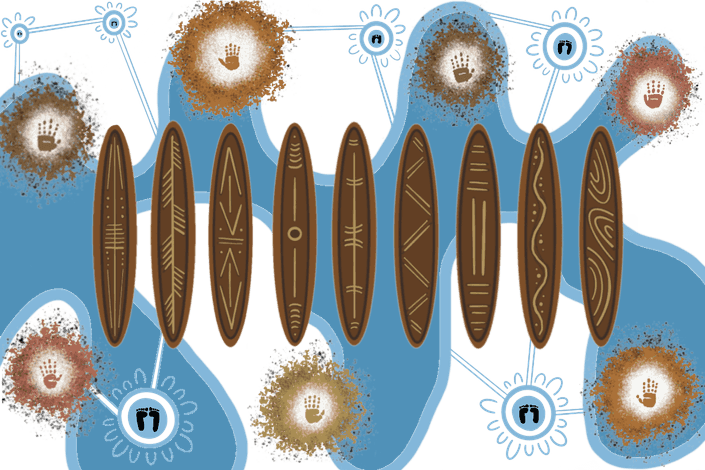Aboriginal and Torres Strait Islander viewers are advised that this website contains the names and images of people who have passed
Aboriginal and Torres Strait Islander viewers are advised that this website contains the names and images of people who have passed

Our History
History of the Royal Commission into Aboriginal Deaths in Custody and the Aboriginal Justice Caucus.
The Aboriginal Justice Caucus' have been advocating for the Victorian Aboriginal community for 25 years, but our history stretches back to the Royal Commission into Aboriginal Deaths in Custody (RCIADIC). Despite the recommendations of RCIADIC being delivered over 35 years ago, many remain relevant, and the Aboriginal and Torres Strait Islander proportion of the prison population in Victoria has almost tripled. While perceptions among Aboriginal organisations and communities differ, there is a shared sense that little has changed in the intervening period, reflected in continuing high rates of Aboriginal incarceration and deaths in custody.
There is no shared understanding between government and Aboriginal communities across Victoria, of where Victoria is at with implementation of RCIADIC recommendations. Not enough has been done. RCIADIC recommendations have ongoing relevance, because the fundamental design of the ‘justice’ system remains the same, and Aboriginal over-representation continues to rise.
Read more about some of the key moments in our history below.

Royal Commission into Aboriginal Deaths in Custody (1991)
In 1991, the Royal Commission into Aboriginal Deaths in Custody (RCIADIC) handed down a report which included 339 recommendations to Commonwealth, and state and territory governments, primarily aimed at reducing over-incarceration and its precursors to keep Aboriginal and Torres Strait Islander peoples out of prison. The largest number of RCIADIC recommendations relate to policing, criminal justice, incarceration, and coronial responses to Aboriginal deaths in custody. Recommendations also span social and economic development-related portfolios such as health, education, employment and self-determination in recognition of the breadth of factors leading to high rates of incarceration of Aboriginal and Torres Strait Islander peoples.

The first phase of the Victorian Aboriginal Justice Agreement was signed (2000)
In the years immediately following completion of the RCIADIC, all jurisdictions were required to report annually on implementation progress. There was regular government reporting on implementation in Victoria. In 1997, the National Ministerial Summit on Indigenous Deaths in Custody was held to assess implementation of RCIADIC recommendations and examine new strategies to address the over-representation of Aboriginal and Torres Strait Islander people in the criminal legal system. The Summit resulted in a shift away from annual reporting.
As a result of this, the Victorian Government developed the Aboriginal Justice Agreement (AJA) in partnership with the Victorian Aboriginal community, which sought to improve justice outcomes for Aboriginal people and reduce the over-representation of Aboriginal people in the Victorian ‘justice’ system. This Agreement, launched in 2000 and now in its fourth phase, is the longest running of its kind in Australia.
Previous Reviews of RCIADIC's implementation in Victoria
Before "Looking Back", there had been two reviews of Victoria’s RCIADIC implementation.
2005 Victorian Implementation Review (2005 Review)
The 2005 Review arose from a commitment under the first phase of the AJA to conduct a joint review that examined government’s self-assessments of implementation progress for RCIADIC recommendations through the views and experiences of the Aboriginal community. While government self-assessments identified 61 % of recommendations as complete, the review found significant disparities between what the Aboriginal community was experiencing and what was being reported by government departments and agencies.
The 2005 Review differed to earlier reviews as it was led by two independent and highly respected Aboriginal co-chairpersons and provided a direct channel for Aboriginal views and experiences concerning the implementation of the RCIADIC recommendations. This review found that despite undeniable progress in areas such as education, health and housing and reforms in the criminal justice system, there was still a long journey ahead to implement all RCIADIC recommendations in Victoria. The review found that policies, programs and initiatives reported on by Victorian governments had not achieved the desired outcome of reducing the over-representation of Aboriginal people in police and prison custody. It made 164 recommendations for further monitoring and work to achieve this aim.
2018 Independent Review of the Implementation of the Recommendations of the RCIADIC (2018 Review)
The 2018 Review, conducted by Deloitte Access Economics, was commissioned by the Commonwealth to understand implementation progress nationally.
This review was desktop based and informed only by government self-assessments of implementation progress. It has been widely criticised for significant methodological limitations and its failure to engage with Aboriginal people and organisations and their perspectives on progress. The review found that 81 of the 300 RCIADIC recommendations applicable to Victoria had not been fully implemented. Relatively large deficiencies in implementation progress were found in the areas of self-determination, cycles of offending, and non-custodial approaches.
Progress on Coronial Recommendations
Current processes for assessing progress

The Coroner’s Court of Victoria (CCoV) is responsible for investigating all reportable deaths, including deaths in custody. Following an investigation, the coroner makes findings as to the cause and circumstances of the death, and sometimes also recommendations that may help prevent similar tragedies.
Coronial investigations of deaths in custody may also consider internal departmental reports, namely those prepared by Justice Health which examine provision of healthcare, and the Justice Assurance and Review Office which examine custodial management and incident response. These reports are not publicly available.
The findings, recommendations, and subsequent responses of coronial investigations will then be published online where an inquest was held, recommendations have been made, or a coroner otherwise orders they be published. However, this means that not all investigations into deaths in custody are published, as only a small proportion (less than five percent) of investigations are held as public inquests and not all findings are accompanied by recommendations
The need to better examine implementation

Where a public statutory authority or entity has committed to action in response to coronial recommendations, there is limited ongoing monitoring of whether these actions have been carried out or if these actions have created change or prevented further deaths in custody.
The AJC has raised concerns over the lack of a consistent and transparent process that monitors progress of coronial recommendations in Victoria. There is a need to ensure recommendations made by the CCoV regarding Aboriginal deaths in custody are being addressed in full, to prevent future deaths in custody. Accordingly, this project will examine implementation progress of coronial recommendations arising from Aboriginal deaths in custody in Victoria since 1991. This will also allow systemic issues and responses to be identified.
Looking Back, Moving Forward: A Victorian Aboriginal-Led Project to End Deaths in Custody
The Aboriginal Justice Caucus have been clear on the need for updated analysis, informed by the principles of self-determination and Aboriginal measures of success to assess Victoria’s recent progress in implementing RCIADIC recommendations, and the effectiveness of implementation. "Looking Back, Moving Forward" is AJC's response to this need. The outcomes of this project provide a clear picture of where work remains necessary to address issues highlighted by the RCIADIC.
Related community partnership structures
Victorian Aboriginal Justice Advisory Committee (VAJAC)
The RCIADIC emphasised that matters of the Criminal Justice System were very much matters for the States and Territories. In these areas many of the recommendations were quite detailed; and as they were areas of ongoing concern; new problems would inevitably develop. To successfully implement the recommendations, the RCIADIC recommended the establishment of an independent Aboriginal Justice Advisory Committee (AJAC) in each State and Territory to capture the views of Aboriginal people and advise Governments on implementation of recommendations.
The Victorian Aboriginal Justice Advisory Committee (VAJAC) was formed to accurately reflect the opinions of all Aboriginal people, the Advisory Committee should include a group of regionally based members to reflect the views of people who live in regional areas.
Regional Aboriginal Justice Advisory Committees (RAJACs)
In 2001, The Regional Aboriginal Justice Advisory Committees (RAJAC) were established, they operate in addition to and independent of the VAJAC. The Committees operated across Victoria, with five regional Committees. Each RAJAC consists of representatives from Aboriginal community organisations responsible for delivery of justice-related services, and representatives from relevant Victorian Government agencies, the Aboriginal and Torres Strait Islander Commission, and local government. Victorian Government agencies typically included in RAJACs were Victoria Police, Community Corrections, Magistrates’ Court, Juvenile Justice and Sheriff’s Office.
The RAJACs are instrumental in developing and maintaining strong partnerships and plans between Aboriginal communities and justice agencies under the AJA. They play an important role in building community participation and involvement in AJA related work, advocating for program and service changes to improve justice outcomes, providing advice and expertise in the development and implementation of place-based initiatives, and ensuring regional issues are raised and responded to via the AJF.

Aboriginal Justice Forum
Over time, membership of the Aboriginal Justice Forum has expanded over time to include additional Aboriginal community representatives. Collectively the Aboriginal community partners to the AJA became known as the Koori Caucus and in more recent years the Aboriginal Justice Caucus (AJC). As described in ‘Burra Lotjpa Dunguludja’ (AJA4) the purpose of the Aboriginal Justice Caucus is to be a conduit between the Aboriginal Community and the justice system. The AJC provides leadership, advocacy and drives changes that will address underlying issues contributing to offending as well as system and programmatic reform across the criminal legal system.
The Aboriginal Justice Caucus membership comprises the Aboriginal signatories to Burra Lotjpa Dunguludja, Aboriginal community members of the AJF, chairpersons of each of the nine RAJACs, representatives from statewide Aboriginal justice programs, Aboriginal peak bodies and Aboriginal Community Controlled Organisations.
